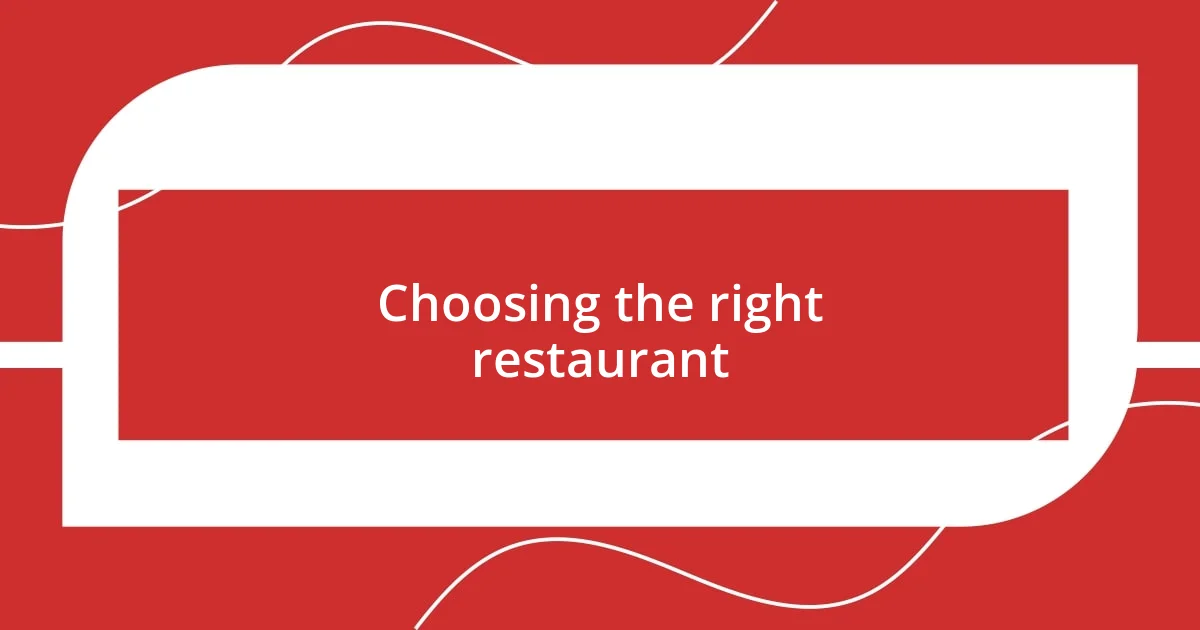Key takeaways:
- Consider the dining experience you want—ambiance, dietary needs, and group preferences enhance enjoyment when choosing a restaurant.
- Understanding menu options, such as specials and dietary symbols, empowers better meal choices and elevates the dining experience.
- Mindful eating practices, like savoring flavors and limiting distractions, foster a deeper connection with food and improve overall satisfaction during meals.

Choosing the right restaurant
Choosing the right restaurant starts with reflecting on what you’re in the mood for that day. I remember a time when I was craving Italian but ended up at a generic chain restaurant because it was convenient. That dining experience fell flat—I realized that the ambiance, the authentic flavors, and the passion behind the cuisine matter more than just filling my stomach.
When I consider my options, I often think about the type of dining experience I want. Do I want a cozy place with soft lighting and quiet corners for deep conversations, or am I seeking a vibrant atmosphere to enjoy good food with friends? I find that a restaurant’s setting can significantly enhance my overall experience. The last time I dined at a local tapas bar, the lively vibe and communal dining turned what could have been a simple meal into a memorable night filled with laughter and sharing.
It’s also essential to consider dietary needs or preferences within your group. Once, I chose a trendy spot without checking the menu, only to discover they had limited vegan options, which left my friend feeling left out. That taught me to not only prioritize my cravings but also ensure that everyone has something delicious to enjoy. After all, isn’t the goal of eating out to connect and savor each moment together?

Understanding menu options
Understanding menu options can feel overwhelming, especially when you’re presented with a multitude of choices. I’ve had nights where I stared at a menu for what felt like an eternity, trying to decipher words like “gastrique” and “sous-vide.” It’s easy to get lost in the jargon, but I’ve learned that breaking it down helps me make better decisions. Familiarizing myself with different cooking techniques and ingredients not only enhances my understanding but also makes me more confident when ordering.
When I approach a menu, I often take a moment to evaluate the options based on a few key considerations:
– Highlight of the Day: I look for specials or chef’s recommendations—these often showcase the establishment’s strengths.
– Ingredient Transparency: I appreciate menus that indicate seasonal or locally sourced ingredients, as they often lead to fresher dishes.
– Dietary Symbols: I scan for icons that indicate gluten-free, vegetarian, or vegan dishes, which is especially helpful when dining with friends who have different needs.
– Personal Favorites: I tend to gravitate toward signature dishes that have received glowing reviews online or from people I trust.
One memorable evening, a friend and I discovered an unexpected delight on a menu that featured a whole page of unique craft cocktails. My choice wasn’t just about the drink; it was about the experience of tasting something new and the excitement that comes from sharing those moments with someone special. Understanding the menu can transform your dining out experience from merely enjoyable to truly remarkable.

Reading nutrition labels
Reading nutrition labels is a crucial practice that I’ve developed over time. I remember a time when I ordered a seemingly healthy salad only to find it packed with hidden sugars and excess calories. Now, as I look at nutrition labels, I pay close attention to the serving size first. It’s remarkable how easily we can misjudge portions, making healthy meals less effective if consumed without awareness.
I also focus on the ingredients list, as it reflects the overall quality of the food. Once, I made a choice based on a label boasting “natural” ingredients, only to discover that many additives were lurking in the fine print. I’ve learned that a good rule of thumb is to choose foods with ingredients that I can recognize and pronounce. This practice not only makes me feel empowered about what I consume, but it also helps me align my meals with my health goals.
Lastly, I check for the percent daily value (%DV) for nutrients like fiber, sugars, and fat. Higher percentages often indicate whether I’m making a choice that contributes to my overall well-being. One memorable dinner out, I opted for a dish that was rich in fiber and surprisingly low in sugars, which left me feeling satisfied, not sluggish. It’s all about finding that balance between enjoying what I eat and nourishing my body in the best way possible.
| Nutrition Label Component | What to Look For |
|---|---|
| Serving Size | Understand the portion to avoid overeating |
| Ingredients List | Choose recognizable ingredients; avoid hidden additives |
| % Daily Value (%DV) | Aim for higher fiber and lower sugar content |

Making smart substitutions
Making smart substitutions can be a game-changer when dining out. I often swap sautéed vegetables for fries, and it never fails to surprise me how much I enjoy them. The vibrant flavors and textures add depth to my meal, and I leave feeling pleased with my healthier choice.
Sometimes, I like to ask for dressings or sauces on the side. I remember one time when I requested the vinaigrette separately—what a difference it made! This simple request allowed me to control the amount I used, significantly cutting down on those hidden calories. Have you ever made a similar adjustment? It’s one of those small yet impactful tweaks that can enhance both flavor and nutritional value.
I also appreciate asking for whole-grain options instead of refined choices, like opting for whole grain bread instead of white. I recall a cozy dinner date where I made that switch; it added a nutty richness to my sandwich that made it even more satisfying. Not only did it taste better, but it also kept my energy steady throughout the evening. By making these thoughtful substitutions, I feel more in control of my dining experience, and that’s something I truly enjoy.

Portion control strategies
When it comes to portion control, I’ve found that sharing meals can be incredibly effective. I often suggest splitting a dish with a friend or family member. There’s something quite nice about trying different flavors without overindulging. On one occasion, I shared a pizza with a friend, and we ended up savoring each slice while leaving the table feeling satisfied rather than stuffed. Have you ever noticed how sharing not only cuts down on portion sizes but also adds to the social experience of dining out?
Another strategy I employ is to use smaller plates provided by the restaurant. It may seem simple, but choosing a smaller plate tricks my mind into feeling like I’ve eaten more than I actually have. I remember a dinner where I opted for a smaller bowl for my pasta. It made a noticeable difference! By the end of the meal, I felt just the right amount of full, not to mention I enjoyed the dining atmosphere more. Do you think a change in the size of the plate could alter your perception of portion sizes?
Lastly, I make sure to have a plan before heading out to eat. Something I always do is check the menu online and decide on my order ahead of time. This way, I avoid the impulse to overindulge when I’m tempted by the delicious options in front of me. One evening, I studied the menu beforehand and settled on a lighter option, saving myself from potential regret after a heavy meal. Planning isn’t only about making healthy choices; it also eliminates the stress of decision-making when I’m at the restaurant. Have you ever considered how a little forethought could shape your dining experience?

Navigating dietary restrictions
Navigating dietary restrictions
Navigating dietary restrictions while dining out can feel daunting, but I’ve learned a few tricks along the way. For instance, when I discovered I was sensitive to gluten, it was initially overwhelming to find places that offered suitable options. I recall my first experience at a restaurant known for its pasta; I nervously asked the server if they had gluten-free alternatives. To my surprise, not only were they accommodating but the gluten-free dish I ended up ordering was fantastic! Have you had a similar experience that made you feel more confident in your choices?
One thing I always do is to communicate openly with the staff. I remember dining at a new restaurant where I had to explain my nut allergy. The server was incredibly understanding and even suggested some dishes that were safe for me. For a moment, I felt a wave of relief wash over me, knowing I was in good hands. It’s essential to trust that restaurants want to cater to guests with dietary needs, making it easier to enjoy the experience without worry.
Another vital aspect of managing dietary restrictions is researching restaurants beforehand. I often check reviews and menus online to see if they have reputations for accommodating different diets. There was this one time I found an eatery celebrated for its vegan options, which excited me because I was dining with a friend who had just transitioned to a plant-based lifestyle. We both enjoyed the meal so much that it opened my eyes to how delicious mindful eating can be. Have you ever stumbled upon a gem of a restaurant that completely aligned with your dietary needs? These discoveries can transform dining from a stressful endeavor into a celebratory experience.

Enjoying meals mindfully
When I think about enjoying meals mindfully, I always focus on the experience itself rather than just the food. For me, this means taking a moment to truly appreciate the aroma and presentation of each dish. I remember dining at a charming bistro where the scent of fresh herbs filled the air. Instead of diving right in, I paused to inhale that delicious fragrance, which made every bite more enjoyable. Have you ever taken a moment to just breathe in the ambiance before starting your meal?
Another technique I’ve adopted is to limit distractions while eating. I consciously keep my phone away, allowing myself to be present at the table. There was a time when my friend and I decided to have a tech-free dinner. We found ourselves laughing and engaging in deep conversations, enjoying our meals without the usual distractions. It really struck me then how disconnecting from screens made our dining experience so much richer. How often do you find yourself distracted when you could be savoring those moments?
Lastly, I like to slow down with each bite. I’ve found that chewing slowly not only enhances the flavors but also helps me tune in to my body’s hunger signals. One memorable occasion was at a quiet restaurant where I deliberately took my time with a beautifully prepared dish. By carefully savoring each flavor, I recognized when I was satisfied much sooner than I expected. I realized then how important it is to listen to what your body is telling you while you eat. Have you ever tried to truly taste and enjoy every bite? It can transform the way you perceive your meal.












